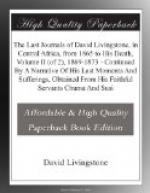24th November, 1872.—Left Kampamba’s to-day, and cross a meadow S.E. of the village in which the River Muanani rises. It flows into the Kapondosi and so on to the Lake. We made good way with Kiteneka as our guide, who formerly accompanied Kampamba and ourselves to Liemba. We went over a flat country once covered with trees, but now these have all been cut down, say 4 to 5 feet from the ground, most likely for clearing, as the reddish soil is very fertile. Long lines of hills of denudation are in the distance, all directed to the Lake.
We came at last to Kasonso’s successor’s village on the River Molulwe, which is, say, thirty yards wide, and thigh deep. It goes to the Lofu. The chief here gave a sheep—a welcome present, for I was out of flesh for four days. Kampamba is stingy as compared with his father.
25th November, 1872.—We came in an hour’s march to a rivulet called the Casembe—the departed Kasonso lived here. The stream is very deep, and flows slowly to the Lofu. Our path lay through much pollarded forest, troublesome to walk in, as the stumps send out leafy shoots.
26th November, 1872.—Started at daybreak. The grass was loaded with dew, and a heavy mist hung over everything. Passed two villages of people come out to cultivate this very fertile soil, which they manure by burning branches of trees. The Rivulet Loela flows here, and is also a tributary of the Lofu.
27th November, 1872.—As it is Sunday we stay here at N’dari’s village, for we shall be in an uninhabited track to-morrow, beyond the Lofu. The headman cooked six messes for us and begged us to remain for more food, which we buy. He gave us a handsome present of flour and a fowl, for which I return him a present of a doti. Very heavy rain and high gusts of wind, which wet us all.
28th November, 1872.—We came to the River Lofu in a mile. It is sixty feet across and very deep. We made a bridge, and cut the banks down, so that the donkey and cattle could pass over. It took us two hours, during which time we hauled them all across with a rope. We were here misled by our guide, who took us across a marsh covered with tufts of grass, but with deep water between that never dries; there is a path which goes round it. We came to another village with a river which must be crossed—no stockade here, and the chief allowed us to camp in his town. There are long low lines of hills all about. A man came to the bridge to ask for toll-fee: as it was composed of one stick only, and unfit for our use because rotten, I agreed to pay provided he made it fit for our large company; but if I re-made and enlarged it, I said he ought to give me a goat for the labour. He slunk away, and we laid large trees across, where previously there was but one rotten pole.
29th November, 1872.—Crossed the Loozi in two branches, and climbed up the gentle ascent of Malembe to the village of Chiwe, whom I formerly called Chibwe, being misled by the Yao tongue. Ilamba is the name of the rill at his place. The Loozi’s two branches were waist deep. The first was crossed by a natural bridge of a fig-tree growing across. It runs into the Lofu, which river rises in Isunga country at a mountain called Kwitette. The Chambeze rises east of this, and at the same place as Louzua.




